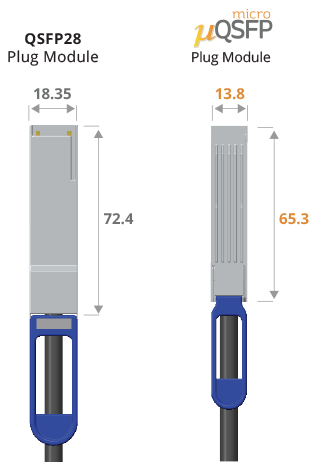标准光模块
MicroQSFP光模块


QSFP28 (foreground) and microQSFP plug modules

QSFP28 (foreground) and microQSFP plug modules

Features:
- 33% increase in density over QSFP (based on 48 microQSFP ports vs. 36 QSFP ports in 365mm)
- Same 4 channel electrical interface as QSFP
- Same 3.5+W power capability as QSFP+
- Will support 25G and 50G (PAM4) electrical data rates
Benefits:
- Functionality of QSFP in SFP density
- Significantly improved thermal management
- Accommodates multiple electrical interface generations (4 channels, to 2 channels, to 1 channel), while supporting a long life optical interface WITHOUT changing form factor
- Enables up to 72 ports per 1RU line card
Summary:
- Enables a second generation line card with higher port density than a QSFP based line card
- Enables the same IO density as SFP with improved thermal management and increased bandwidth density


Then members of the μQSFP MSA supporters:F-tone Networks,Avago Technologies, Broadcom, Brocade, Cisco, Dell, Huawei, Intel, JDSU, Juniper Networks, Microsoft, Molex, and TE Connectivity. The MSA members plan to define a new standardized higher-density, thermally-enhanced form factor, which will allow interoperable copper and fiber-based transceiver module markets to expand rapidly with broad support.
Compared to the QSFP module form factor, the μQSFP is being specified to provide 33% higher port density with a thermally-enhanced housing for a broad range of networking applications including datacenter interconnect, storage connectivity, and high-performance computing. In addition, the µQSFP will be the same width as the existing SFP form factor, resulting in a more capable high-density solution. The μQSFP is expected to support communications over copper and fiber cabling at various data rates.
“The steady march to higher speeds at maximum density will challenge existing form factors, particularly from a thermal management perspective,” said Dale Murray, Principal Analyst for LightCounting Market Research. “Proliferation of form factors is also challenging. By taking a fresh, holistic approach to a next-generation form factor covering both single and multiple lanes, this new MSA could provide a path to a broad solution.”
The µQSFP specification will define requirements for a form factor supporting up to four electrical channels, higher system density, and a thermally-enhanced solution. Support for 28 gigabits per second (Gb/s) data rates on each channel enables many applications including 10 Gigabit Ethernet, 25 Gigabit Ethernet, 50 Gigabit Ethernet, and 100 Gigabit Ethernet, where higher densities are required than are possible with existing form factors. It is expected that the electrical interface and form factor will enable increased channel data rates in the future such as 50 Gb/s. The MSA scope includes specification of electrical, mechanical, and management interfaces that will include electrical connector, guide rail (cage), front panel and host PCB layout, and optical connector options. By addressing the thermal, signal integrity, electromagnetic and electrostatic challenges of a higher density solution, the µQSFP MSA Group will enable higher density networking products which are critical to support the continuing network demand.
